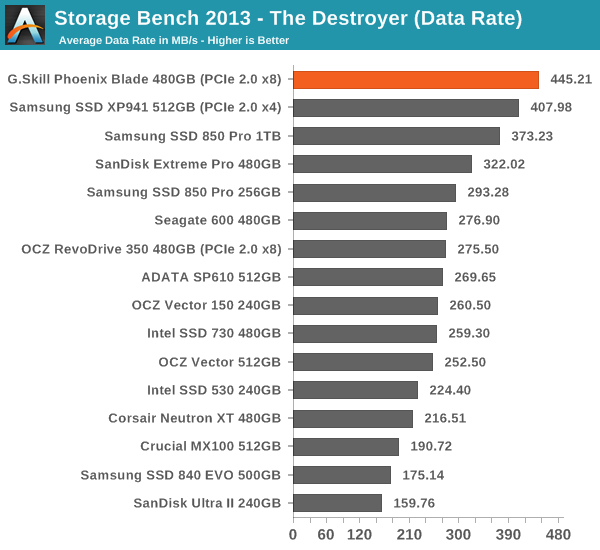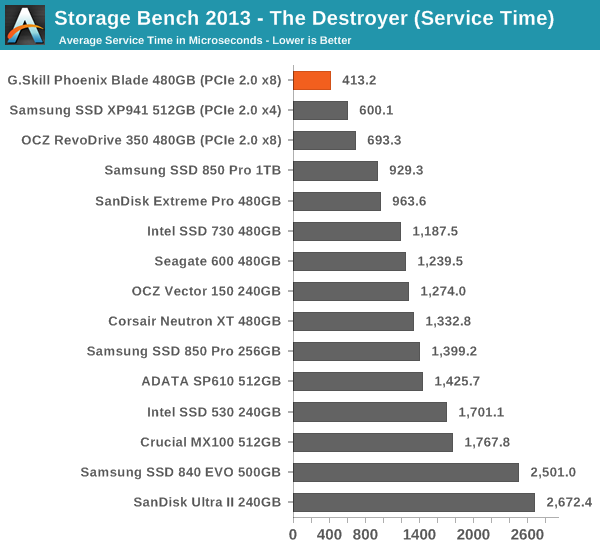G.Skill Phoenix Blade (480GB) PCIe SSD Review
by Kristian Vättö on December 12, 2014 9:02 AM ESTAnandTech Storage Bench 2013
Our Storage Bench 2013 focuses on worst-case multitasking and IO consistency. Similar to our earlier Storage Benches, the test is still application trace based – we record all IO requests made to a test system and play them back on the drive we are testing and run statistical analysis on the drive's responses. There are 49.8 million IO operations in total with 1583.0GB of reads and 875.6GB of writes. I'm not including the full description of the test for better readability, so make sure to read our Storage Bench 2013 introduction for the full details.
| AnandTech Storage Bench 2013 - The Destroyer | ||
| Workload | Description | Applications Used |
| Photo Sync/Editing | Import images, edit, export | Adobe Photoshop CS6, Adobe Lightroom 4, Dropbox |
| Gaming | Download/install games, play games | Steam, Deus Ex, Skyrim, Starcraft 2, BioShock Infinite |
| Virtualization | Run/manage VM, use general apps inside VM | VirtualBox |
| General Productivity | Browse the web, manage local email, copy files, encrypt/decrypt files, backup system, download content, virus/malware scan | Chrome, IE10, Outlook, Windows 8, AxCrypt, uTorrent, AdAware |
| Video Playback | Copy and watch movies | Windows 8 |
| Application Development | Compile projects, check out code, download code samples | Visual Studio 2012 |
We are reporting two primary metrics with the Destroyer: average data rate in MB/s and average service time in microseconds. The former gives you an idea of the throughput of the drive during the time that it was running the test workload. This can be a very good indication of overall performance. What average data rate doesn't do a good job of is taking into account response time of very bursty (read: high queue depth) IO. By reporting average service time we heavily weigh latency for queued IOs. You'll note that this is a metric we have been reporting in our enterprise benchmarks for a while now. With the client tests maturing, the time was right for a little convergence.

Quite surprisingly, the Phoenix Blade takes the lead in our 2013 Storage Bench and even beats the XP941. After reviewing the RevoDrive 350, I didn't get my hopes up for the Phoenix Blade, but it looks like G.Skill has done a much better job at optimizing the drive for performance.











62 Comments
View All Comments
otherwise - Monday, December 15, 2014 - link
For those interested, here is the P3xxx series page at intel, which used to contain all three models, but now just the P3600 and P3700: http://www.intel.com/content/www/us/en/solid-state...otherwise - Monday, December 15, 2014 - link
Fixed link: http://www.intel.com/content/www/us/en/solid-state...r3loaded - Friday, December 12, 2014 - link
Is anyone ever going to get around to producing a native PCIe drive that's actually available at retail for enthusiasts to buy for their systems? Bonus points if it supports NVMe. The SSD in my MacBook Pro is faster than the one in my desktop PC and that just doesn't sit right with me.biostud - Friday, December 12, 2014 - link
Can't it boot from a X99 setup?FunBunny2 - Friday, December 12, 2014 - link
The text says 2281, but the table 2282?? Typo? Matter much?Antronman - Friday, December 12, 2014 - link
For just $300 more, I'll take an iO-FX any day over this PCIe SSD.Poik - Friday, December 12, 2014 - link
Only price I see for an iO-FX is $1380 from Amazon. That's pretty much $700 more or double the price. Even so for an extra $300 I'd rather have 2 XP941's.Antronman - Friday, December 12, 2014 - link
I was comparing Amazon costs, as I found the Phoenix Blade 480GB for $1000 on Amazon. But after checking Newegg, it is only $680 on Newegg. Oh well. The iO-FX is still worth it. The speed and reliability is simply second to none. While it might be a little bit overkill for the average consumer, I don't believe PCIe SSDs (especially ones this expensive) are for the average consumer. If you're buying a single storage drive that costs $680, you can buy a storage drive that costs $1400.bill.rookard - Friday, December 12, 2014 - link
Interesting piece of hardware, but I'm interested in it more for my used servers. I have several running and something with that kind of durability rating and the all important backwards compatibility and form factor would allow me to have all kinds of fun with that on my Xeon box.Of course, two of them would set me back $1500.00 - details, details.
Supercell99 - Saturday, December 13, 2014 - link
My guess is for a server environment, something that has to be 24/7, a product this new should be tested for a while before I would put it into a production machine, just to see what happens :)